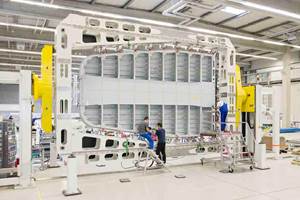PlastiComp introduces carbon-glass hybrid LFT
The new hybrid composite pellet products combine long glass fiber and long carbon fiber together, bridging the performance gap between either fiber used alone.
PlastiComp, Inc. (Winona, Minn., USA), a supplier of long fiber thermoplastic (LFT) materials and technologies, has developed an innovative set of hybrid thermoplastic composites that combine long glass fiber and long carbon fiber reinforcement together in a single, ready-to-mold composite pellet. The new products expand the performance range of long fiber material options available to product designers while offering a cost effective avenue to adopt the high performance capabilities of carbon fiber.
“PlastiComp’s new hybrid long glass+carbon fiber reinforced products really hit a sweet spot that nicely bridge the performance gap between using either of these fibers by themselves,” said Eric Wollan, business development manager at PlastiComp. “The carbon fiber significantly boosts strength and stiffness while the glass fiber allows the toughness that many choose LFT materials for to be retained. Strength and toughness are key long fiber attributes that can’t be achieved in unison with other reinforcement methods.”
A nylon 6/6 hybrid 40 percent long glass+carbon fiber reinforced composite with 20 percent carbon fiber and 20 percent glass fiber has a tensile strength of 41,200 psi (284 MPa), which is 96 percent that of an equivalently loaded long carbon fiber material and 24 percent higher than a similar long glass fiber material. It possesses a flexural modulus of 2,600 ksi (17,931 MPa), which is 87 percent that of carbon and 86 percent higher than glass. The inclusion of long glass fiber allows the material to retain 78 percent of the un-notched impact capability of glass at 18.8 ft·lb/in (1,004 J/m), which is a 25 percent improvement over carbon alone.
“There is an interesting synergy taking place in these hybrid long glass+carbon fiber composites,” said Wollan. “We can reduce the amount of carbon fiber used by half and still keep 85-95 percent of the strength and stiffness, plus the addition of glass fiber is bumping up the durability by up to 25 percent. That performance combination really makes these products attractive, because they land right where a lot of people need to be to use LFT composites as substitutes for metals.”
“Although long carbon fiber reinforced composites are the pinnacle of thermoplastic performance, economically their use can’t be justified in a lot of applications,” says Wollan. “Now, with these new hybrid long glass+carbon fiber composites, PlastiComp has a stepping stone material in the middle of the glass fiber to carbon fiber gap that can be 20-50 percent less expensive with hardly any performance hit.”
PlastiComp can customize the percentage combinations of glass and carbon fiber in these hybrid LFT materials to tailor performance and cost to meet individual application specifications across any market segment. They are especially advantageous to consumer and sporting goods products where the inclusion of carbon fiber allows them to be marketed as utilizing high performance composites and obtain a price premium. The cost/benefit ratio of these composites should be attractive to the automotive and transportation industries that are aggressively trying to reduce weight for improved fuel economy and lower emissions. They are strong contenders for under-the-hood components that require elevated temperature and load bearing capabilities.
PlastiComp manufactures its trademarked LFT Complēt composite pellets using an optimized pultrusion process that maximizes resin and fiber bonding to obtain the highest possible mechanical properties. Hybrid long glass+carbon and other LFT composites from PlastiComp are made-to-order in polymers from polypropylene to PEEK.
As a vertical, full-service long fiber compounder, PlastiComp can provide design and analysis services when converting applications to new materials as well as partnering with OEMs on new product development programs to customize LFT materials and processes to meet specific performance criteria.
Related Content
COMPINNOV TP2 project promotes use of thermoplastics in aerospace
Completed in 2023, COMPINNOV TP2 explored thermoplastic composites, enhancing the understanding between prepregs and production methods to foster the potential for French aerospace innovation.
Read MoreFrom the CW Archives: Airbus A400M cargo door
The inaugural CW From the Archives revisits Sara Black’s 2007 story on out-of-autoclave infusion used to fabricate the massive composite upper cargo door for the Airbus A400M military airlifter.
Read MorePrepreg compression molding supports higher-rate propeller manufacturing
To meet increasing UAV market demands, Mejzlik Propellers has added a higher-rate compression molding line to its custom CFRP propeller capabilities.
Read MoreComposite Integration presents webinar on liquid resin infusion
On July 30, 2025, company experts will discuss the role of LRI in delivering scalable, OOA composite production for the aerospace sector.
Read MoreRead Next
Ultrasonic welding for in-space manufacturing of CFRTP
Agile Ultrasonics and NASA trial robotic-compatible carbon fiber-reinforced thermoplastic ultrasonic welding technology for space structures.
Read MoreNext-gen fan blades: Hybrid twin RTM, printed sensors, laser shock disassembly
MORPHO project demonstrates blade with 20% faster RTM cure cycle, uses AI-based monitoring for improved maintenance/life cycle management and proves laser shock disassembly for recycling.
Read MoreCutting 100 pounds, certification time for the X-59 nose cone
Swift Engineering used HyperX software to remove 100 pounds from 38-foot graphite/epoxy cored nose cone for X-59 supersonic aircraft.
Read More











